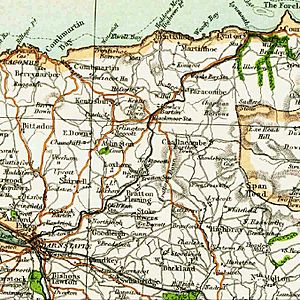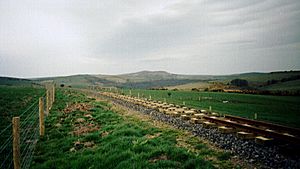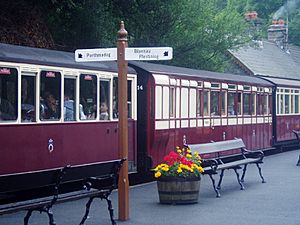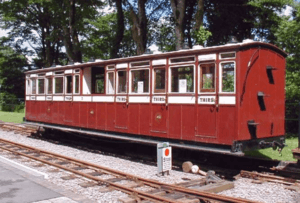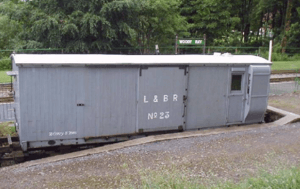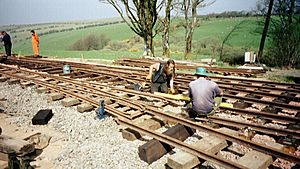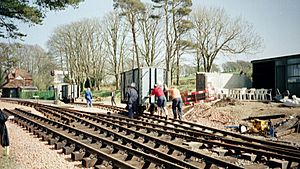Lynton and Barnstaple Railway facts for kids
Quick facts for kids Lynton & Barnstaple Railway |
|
|---|---|

Lyn at Woody Bay in 2017
|
|
| Locale | Exmoor, Devon, England |
| Terminus | Lynton & Lynmouth |
| Commercial operations | |
| Name | Lynton & Barnstaple Railway |
| Built by | Promoter: Sir George Newnes, Bart. Engineer: James Szlumper Contractor: James Nuttall |
| Original gauge | 1 ft 11 1⁄2 in (597 mm) |
| Preserved operations | |
| Owned by | Lynton and Barnstaple Railway Trust |
| Operated by | Lynton and Barnstaple Railway Co. Ltd. |
| Stations | 2 |
| Length | 0.9-mile (1.4 km) |
| Preserved gauge | 600 mm (1 ft 11 5⁄8 in) |
| Commercial history | |
| Opened | 11 May 1898 |
| Closed | 29 September 1935 |
| Preserved era | Woody Bay: mid-1930s |
| Preservation history | |
| 1979 | L&BR Association formed |
| 1993 | Railway Company formed |
| 1995 | Woody Bay station purchased |
| 2000 | Association reformed as Trust |
| 2004 | First train from Woody Bay, 17 July |
| 2005 | Bridge 67 reinstated |
| 2006 | Killington Lane opened |
| 2007 | Over 100,000 passengers carried since reopening |
| 2008 | L&B's first steam loco since 1935 – "AXE" – returned to steam |
| 2010 | "Lyd" – visits Woody Bay |
| 2013 | Three restored Heritage Coaches re-enter service and ISAAC – Bagnall 0-4-2T No. 3023 of 1953 enters service |
| 2017 | New build replica of "Lyn" is completed and unveiled |
The Lynton & Barnstaple Railway (L&B) is a special old railway in North Devon, England. It's known as a Heritage railway because people are working to bring it back to life.
The original railway line first opened in May 1898. It was a single track line, meaning only one train could go at a time. It was a "narrow gauge" railway, which means its tracks were closer together than standard tracks. This made it easier to build through the rugged hills and valleys of Exmoor National Park. The line was just over 19 miles (30 km) long.
For a few years, the L&B made a small profit. But for most of its time, it lost money. The Southern Railway took over the L&B in 1923. They finally closed the railway in September 1935.
In 1979, the Lynton & Barnstaple Railway Association was started. Their goal was to reopen parts of the old line. A short section of the railway opened again in 2004. This section was made longer in 2006. Now, there are plans to open nine miles (14 km) of track. This would connect Woody Bay station to Lynton and Blackmoor Gate, and eventually to a new station at Wistlandpound Reservoir.
Contents
History of the Railway
Many ideas were suggested to build railways from Barnstaple to Lynton. Because of the many hills and valleys, the railway would need tight curves and steep slopes. One plan suggested using a very narrow track width of 1 ft 11 1⁄2 in (597 mm). This width was already used on other lines, like the Ffestiniog Railway. This narrow track would make building the line much easier.
Sir George Newnes supported this plan and became the chairman of the railway company. The law to build the Lynton & Barnstaple Railway was passed on June 27, 1895. The railway officially opened on May 11, 1898, and public trains started running on May 16.
The L&B did not get enough passengers to make money. The journey of almost twenty miles usually took about one and a half hours. Also, Lynton station was built quite far from the town itself. It was also far from the cliff railway that went down to Lynmouth. This made it less convenient for people.
During World War I, fewer people traveled. Also, roads got better, and more people started owning cars. These things cut the railway's income even more. It became too expensive to run.
The Southern Railway tried many ways to save money. They also spent extra money to improve the line. But they still couldn't make a profit. So, they decided to close the railway.
The very last train ran on September 29, 1935. The Southern Railway took away anything they could use on their other lines. By November 8, they had removed the tracks from Lynton to the Barnstaple side of Woody Bay station. On November 13, a sale was held for the railway's remaining parts. However, not many people were interested. Most of the carriages and wagons, and all the engines except Lew, were broken up for scrap metal. Some carriages were even cut up and used as garden sheds. Third-class seats became garden furniture, and first-class seats were used in local public halls. In December, Sidney Castle was hired to take the rest of the railway apart. The remaining track was removed by June 1936. In September, the engine Lew was sent to South America, probably Brazil. The stations and the land where the tracks used to be were sold in 1938.
The L&B had a very good safety record. No members of the public were killed or hurt. However, accidents at Braunton Road and Chumhill did cause the deaths of three railway workers.
The Railway's Path
The L&B line goes up and down many times along its path. It starts at 15 feet (4.6 m) above sea level. The first 3+3⁄4 miles (6.0 km), through Barnstaple and along the Yeo Valley, stays mostly flat.
Collard Bridge is where an 8-mile (13 km) climb begins. This climb is mostly at a slope of one in fifty (2%) and goes up to Blackmoor Gate. After that, there's a slight downhill slope, about 2 miles (3.2 km) long, towards Parracombe Bank. Then, another climb starts, about 2+1⁄2 miles (4 km), leading to Woody Bay. At 1,000 feet (305 m), Woody Bay is the highest railway station in southern England. The line then goes downhill again, mostly at one in fifty, to Lynton & Lynmouth station. This station is still 700 feet (213 m) above the sea. It is hidden from the town of Lynton by the landscape. The tightest curves on the line had a minimum radius of 5-chain (100 m).
Trains and Carriages
One of the most noticeable things about the L&B was its trains and carriages. The engines first appeared in a plain green color with lines. Later, they were painted black with chestnut-colored frames underneath. The passenger carriages were terra-cotta (a reddish-brown) with cream-colored upper panels. The goods wagons were light grey. Over time, the painting became simpler as each vehicle was repainted.
When the Southern Railway took over, and the engine Lew arrived, the paint colors slowly changed. Engines and passenger carriages became a lighter green with yellow letters. Goods wagons were painted brown. The engine headlamps, which had been black, were repainted red.
Engines
At least three different engines were used by builders when the line was being constructed. Interestingly, some of the temporary tracks were wider than the final narrow gauge. For example, the section around Parracombe Bank, crossing the Heddon valley, was built for a 36 gauge. An engine known as Winnie was used there. A fifth engine, possibly named Spondon, might also have been used, but not much is known about it. In 1900, the L&B sold Kilmarnock. It's thought that the builder, James Nuttall, left it behind due to money problems and a legal case with the railway.
The L&B only used coal-fired steam engines. The railway ordered three 2-6-2T engines from Manning Wardle & Co in Leeds. These engines were named after local rivers: Yeo, Exe, and Taw. The company soon realized that three engines wouldn't be enough. So, they added a 2-4-2T engine called Lyn. This engine was built by the Baldwin Locomotive Works in Philadelphia, USA. Baldwin was chosen because they could deliver the engine faster than British builders. British builders had many orders because of a national engineering dispute from July 1897 to January 1898.
After it was built by Baldwin, Lyn was shipped across the Atlantic in parts. Railway staff then put it back together at Pilton. It first steamed in July 1898. The Manning Wardle engines were delivered before the dispute. Yeo and Taw were used to help build the railway line.
In 1923, the L&B became part of the Southern Railway. They started a program to improve things. All the trains and carriages were repainted in Southern Maunsell colors. The tracks and buildings were also made better. A fifth engine, Lew, was bought in 1925. It had a few improvements compared to the original Manning Wardle design.
What Happened to Lew
Lew was bought at the auction in December 1935. It then worked for Sidney Castle, the person who was taking the railway apart. This work finished by July 1936. In September, Lew was moved by train to Swansea. From there, it was shipped to South America, where it simply disappeared. Despite many searches, no one has found any trace of the engine or clues about what happened to it.
Passenger Carriages
Sixteen passenger carriages were ready for the railway's opening. These carriages came in six different types. They were all the same size: 39 ft 6 in (12.0 m) long, 6 ft (1.8 m) wide (7 ft 4 in (2.2 m) including steps), and 8 ft 7 in (2.6 m) high. These were large for narrow-gauge trains. They were also much better than any earlier British narrow-gauge carriages.
The passenger carriages were built very strongly. They offered a much higher level of comfort than other trains at the time, especially compared to other narrow-gauge railways. Almost 70 years later, the Ffestiniog Railway used this design to build a new set of carriages. This shows how good the original design was.
The body for coach 17 was built in 1911 by a local company called Shapland and Petter. It was then put onto a steel frame made by the railway at Pilton. This coach was a bit longer than the earlier ones. It had separate sections for smoking and non-smoking passengers in both first and third class. It also had space for the brake van.
Goods Wagons
The Southern Railway added several new goods wagons. They also bought two used cranes from the War Department for the line.
Trains that carried only goods were not usually used. Instead, goods wagons were usually attached to passenger trains. This meant extra work to move the wagons around at stations along the line. This slowed down the passengers' journey times.
The open goods wagons first came with a single door that opened from the top on each side. But these doors didn't work very well. So, all of them were eventually changed to have double doors that opened from the side. By 1907, most of them also had rails for holding tarpaulins (waterproof covers). The goods vans used the same underframe (the base of the wagon). They had double sliding doors on each side.
Van 23, which is now restored and at Woody Bay, was built at Pilton by the L&B. Unlike all other L&B vehicles, its underframe was made entirely of wood.
The traveling cranes were bought from the War Department. They had special supports called outriggers. These allowed them to lift up to 4½ tons. They were meant to be used as recovery cranes if a train went off the tracks. However, they were not used very often. One crane was kept at Pilton, and the other was used in Lynton goods yard.
The goods vans from 1927 originally had heavy wooden cross braces at each end. These were later replaced with single metal braces.
The Railway Today
More than seventy-five years after it closed, much of the railway line can still be seen. The most impressive part is Bridge 22, also known as the Chelfham Viaduct. This brick bridge was fully restored in 2000. Its eight arches are 42-foot (13 m) wide and reach 70 feet (21 m) above the Stoke Rivers valley. It is the largest narrow-gauge railway structure in England.
The stations at Lynton and Bratton Fleming are now private homes. Blackmoor Gate is a restaurant, and Barnstaple Town is a school. Chelfham and Woody Bay stations are both owned by the new L&B. Chelfham station is used for storage. Woody Bay is the main place where the railway operates. Snapper Halt was bought in 2010 by Exmoor Associates. This is a private company that works to secure land for restoring the railway.
Restoring the Railway
Unlike other old railways, the land where the tracks used to be was sold off in many small pieces. Often, it was sold back to the original owners, who paid much less than they had sold it for. Some minor buildings have been built on parts of the route. Also, Wistlandpound Reservoir has flooded the track bed near its middle. However, much of the old line is still in open countryside, and many sections can still be identified.
The Lynton & Barnstaple Railway Association was formed in 1979. Since 2000, it has been a charity. The Lynton and Barnstaple Railway Company bought Woody Bay Station in 1995. After a lot of hard work, a short section of the railway reopened for passengers in 2004. This section was made longer to over a mile in 2006. Now, steam and diesel trains run between Woody Bay and the new, temporary station at Killington Lane Station.
In 1995, the Lynbarn Railway was created at the Milky Way, a theme park near Clovelly. L&B volunteers operated this railway. The money earned from it helped pay for buying, restoring, and reopening Woody Bay. The Lynbarn was given to the theme park in 2005, once Woody Bay was up and running. It still operates as part of the attraction today.
Most of the original railway vehicles did not survive. But Van 23 is on display at Woody Bay. Coach 7 and Coach 17 are currently being rebuilt. The remains of several other carriages and Goods Van 4 are being stored. They are waiting to be rebuilt. These carriages will then be used as a "Heritage Train" to go along with more modern carriages.
Coach 2 was sold and used as a summer house. It is now on display at the National Railway Museum in York. It has nameplates from the original engines. Coach 15 was found at Snapper Halt in 1959. It was rebuilt by the Ffestiniog Railway in North Wales. It has been running there (now as FR Coach 14) for longer than it did on the L&B. In September 2010, Coach 15 visited the L&B with the Lew replica engine, Lyd.
A "Joffre" class 0-6-0 steam engine built by Kerr Stuart in 1915 was bought in 1983. It was named Axe. It was restored and started working again in 2008. Axe now pulls most of the passenger trains at Woody Bay. An 0-4-0 engine built by Maffei of Germany in 1925, now named Sid, is owned by several L&B members. It is also sometimes used for the L&B steam service.
The Trust owns three industrial diesel engines. One of these, named Heddon Hall, is sometimes used instead of the steam engines. It is also used for trains that carry equipment for railway work.
A number of other visiting diesel and steam engines have also run on the line.
Future Plans
Restoring passenger services from Woody Bay was a huge project for the dedicated volunteers. Even though much of the old track bed still exists, there are several challenges. For example, Wistlandpound Reservoir covers part of the old track. These challenges must be overcome to restore most of the original route.
In October 2007, the railway announced plans to rebuild enough track to reopen nine miles (14 km) of the line. This would connect Woody Bay station to Lynton (at a new station closer to the town) and Blackmoor Gate. It would also go as far as a new station at Wistlandpound.
This project, called Exmoor Enterprise, is expected to cost around £30 million. This includes building replica trains and improving the line. The railway believes this project will bring in over £70 million for the economy of the southwest of England within five years.
Long-term plans include reopening the line all the way towards Barnstaple.
Images for kids


